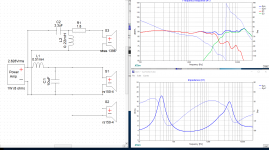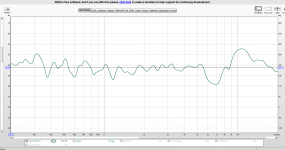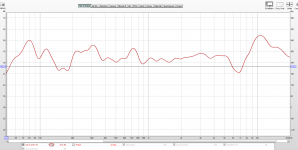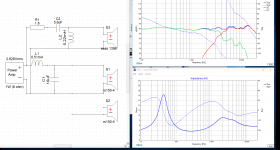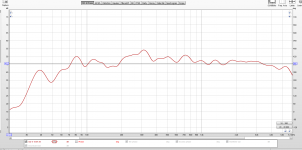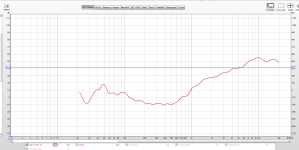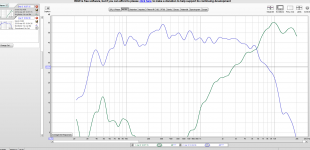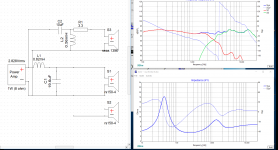Hi!
I am building a 2way front bookshelf speakers.I have done a crossover by my self,and is confused why it is sounding a little bit of(is playing in a box). My combination is!
dayton 6" rs150p4 woofer
seas h1396 tweeter
19mm mdf board,and silent coat 5mm inside(maybe toolite damping) And 20cm(8"x2" vent ) and a 0,38ft3 box exclusive woofer and vent. In music it is good,in a movie it can be sounding very odd in speech, not always, maybe it is litte off a input difference too.
I am building a 2way front bookshelf speakers.I have done a crossover by my self,and is confused why it is sounding a little bit of(is playing in a box). My combination is!
dayton 6" rs150p4 woofer
seas h1396 tweeter
19mm mdf board,and silent coat 5mm inside(maybe toolite damping) And 20cm(8"x2" vent ) and a 0,38ft3 box exclusive woofer and vent. In music it is good,in a movie it can be sounding very odd in speech, not always, maybe it is litte off a input difference too.
Attachments
It looks like your crossover frequency is 4kHz, which is high for a 6" midrange driver. The RS150P-4 datasheet shows beaming begins around 2.2kHz, and cone breakup around 5kHz.
A 2kHz crossover frequency would produce better polar response, and less midrange cone break-up distortion. You will probably be satisfied with an LR2 cricuit on the midrange, but a BW3 circuit would further attenuate the 5kHz RS150P-4 cone breakup.
A 2kHz crossover frequency would produce better polar response, and less midrange cone break-up distortion. You will probably be satisfied with an LR2 cricuit on the midrange, but a BW3 circuit would further attenuate the 5kHz RS150P-4 cone breakup.
Does your data include differing distance (depth) from the listener? The starting point in space for energy from each is seldom the same, which shows as different relative delay in their signals. With a 4kHz crossover, only 1.7inches worth of delay difference would be a phase shift at crossover of 180degrees, putting a big null there.
That's one reason why it's a good idea to measure the drivers in their baffle and determine their relative delay. Dayton's drivers are mostly provided with data referred to the "baffle mounting plane", but SEAS probably aren't.
That's one reason why it's a good idea to measure the drivers in their baffle and determine their relative delay. Dayton's drivers are mostly provided with data referred to the "baffle mounting plane", but SEAS probably aren't.
Does your data include differing distance (depth) from the listener? The starting point in space for energy from each is seldom the same, which shows as different relative delay in their signals. With a 4kHz crossover, only 1.7inches worth of delay difference would be a phase shift at crossover of 180degrees, putting a big null there.
That's one reason why it's a good idea to measure the drivers in their baffle and determine their relative delay. Dayton's drivers are mostly provided with data referred to the "baffle mounting plane", but SEAS probably aren't.
I have measured here,in the rew program.
Attachments
Would you specify measurement conditions? If we assume everything with this measurement was done properly, then there is very much room to improve on the crossover. Try to repeat the measurement far field selecting a larger time window (let's see into the 70 Hz region) and separate measurements of each driver attached to its filter.
Put the resistor before the high pass filter, lower the XO point by increasing the tweeter capacitor. Perhaps you did not understand me so I'll repeat it again. Make a measurement of a woofer and its LP filter by removing from the circuit everything else, and vice versa with tweeter. No wonder speakers sound strange.
Yes, can you verify the volume level was the same with these two measurements? If yes, then you need to increase the tweeter padding further to arrive at the woofer level, increase the woofer cap, and tweeter cap, possibly the tweeter inductor as well. The XO point ought to be in the 3 kHz region.
In general a worthy idea, except for the 0.56 mH. A smaller value like 0.3-0.4 mH will protect the tweeter a litlle better. Measure this circuit or better, prepare the measurements of the raw drivers in the box, frd's and zma's, then use it in a simulator. Search the forum on how to do this properly. Personally I am quicker at exchanging real parts than preparing a proper simulation. This crossover project is a half of an hour job.
- Status
- This old topic is closed. If you want to reopen this topic, contact a moderator using the "Report Post" button.
- Home
- Loudspeakers
- Multi-Way
- Dayton diy
